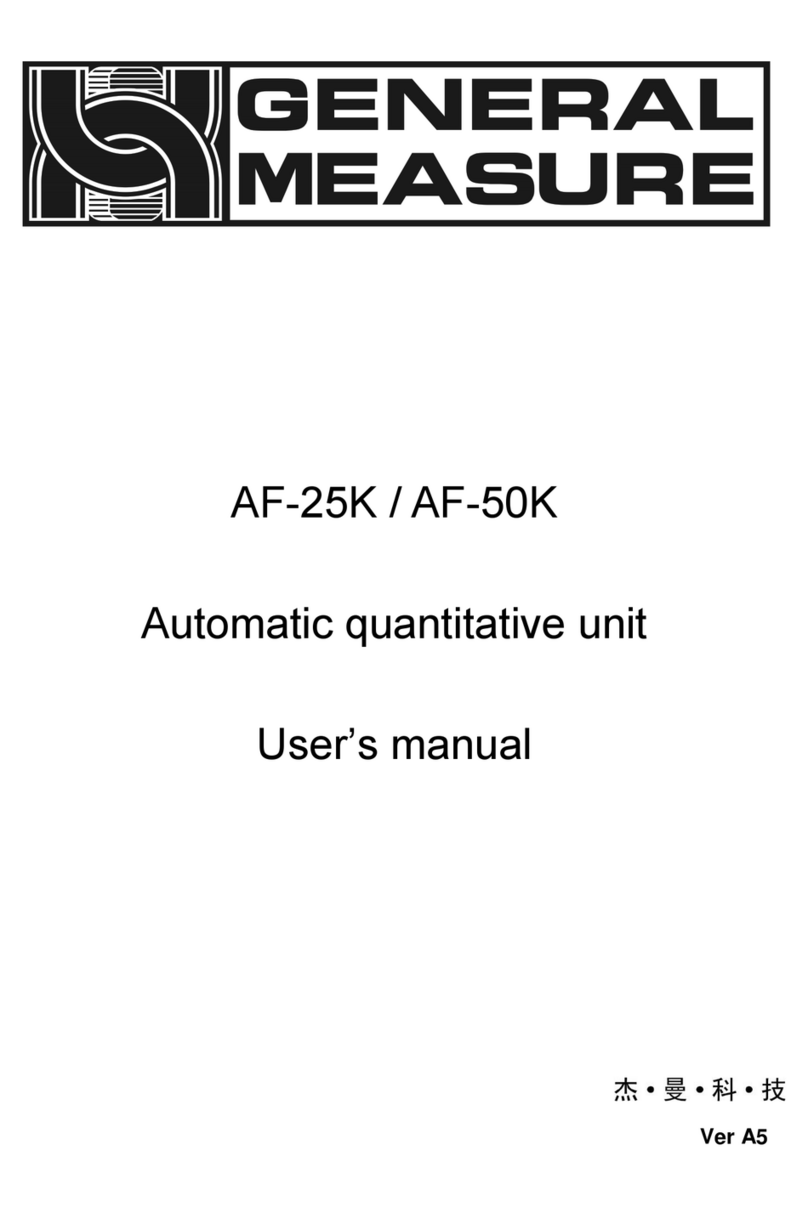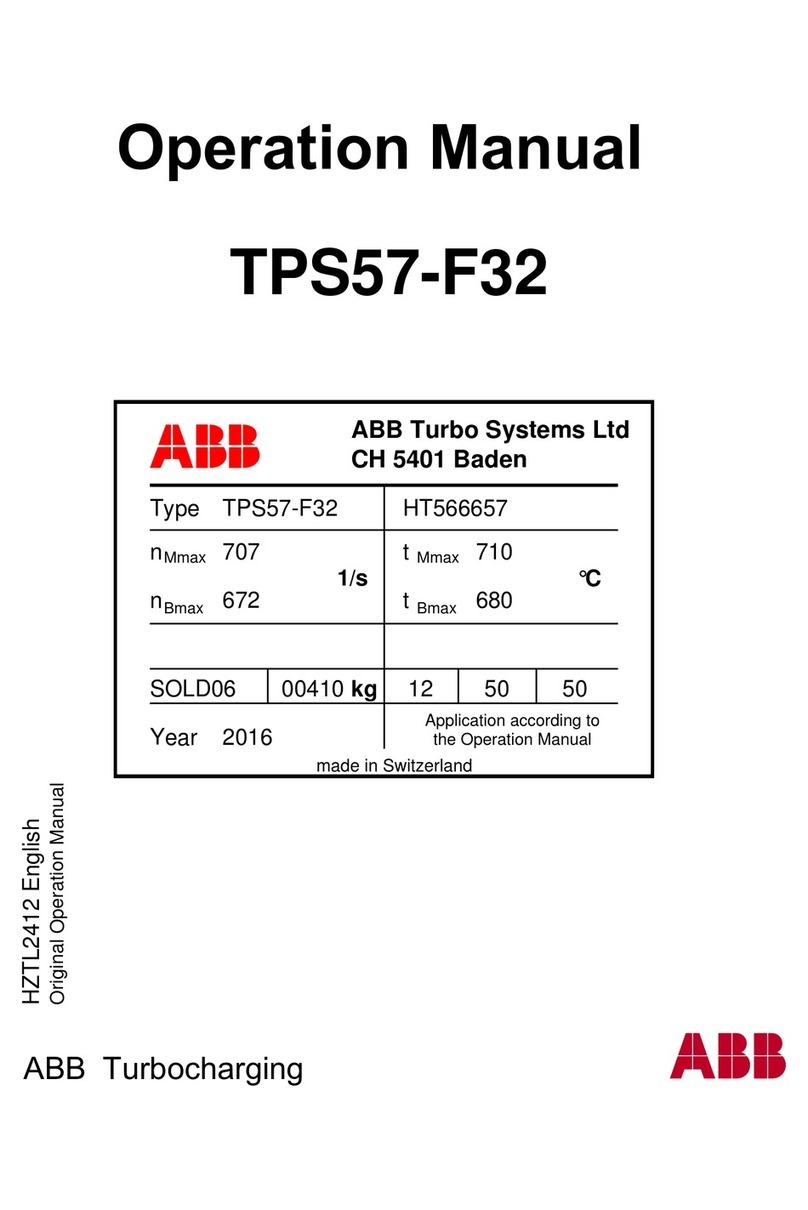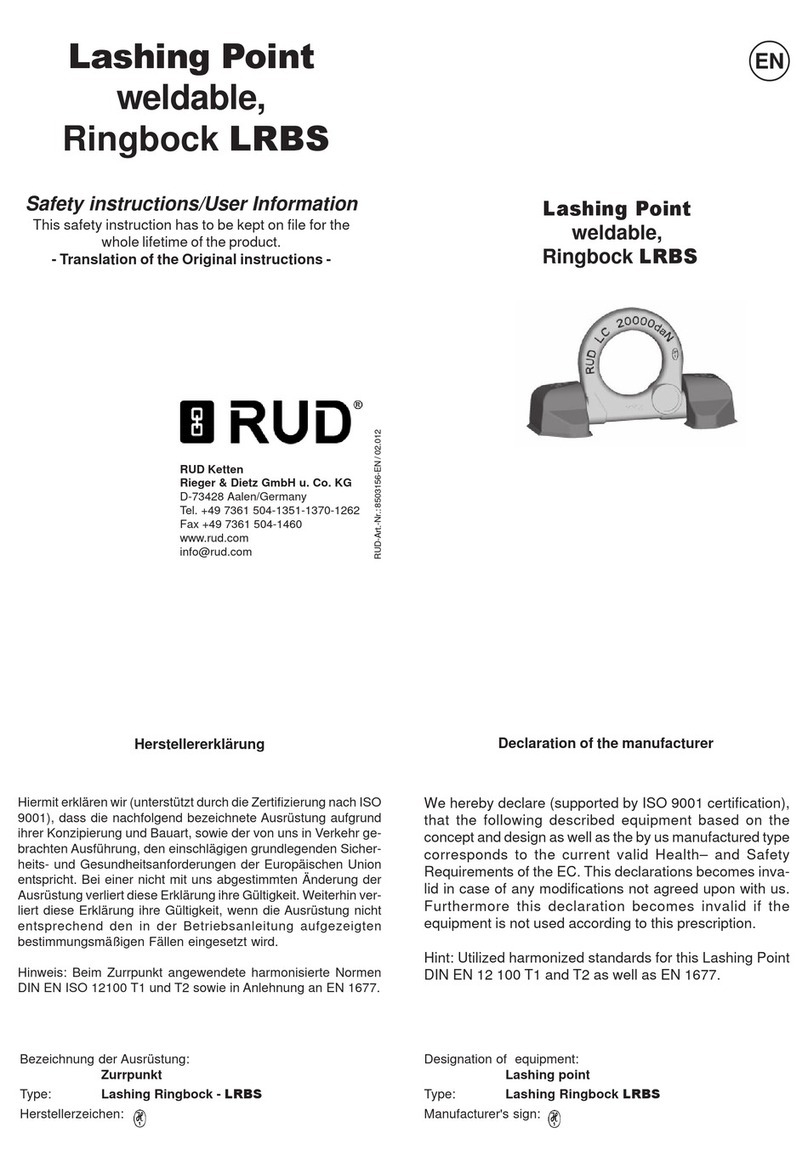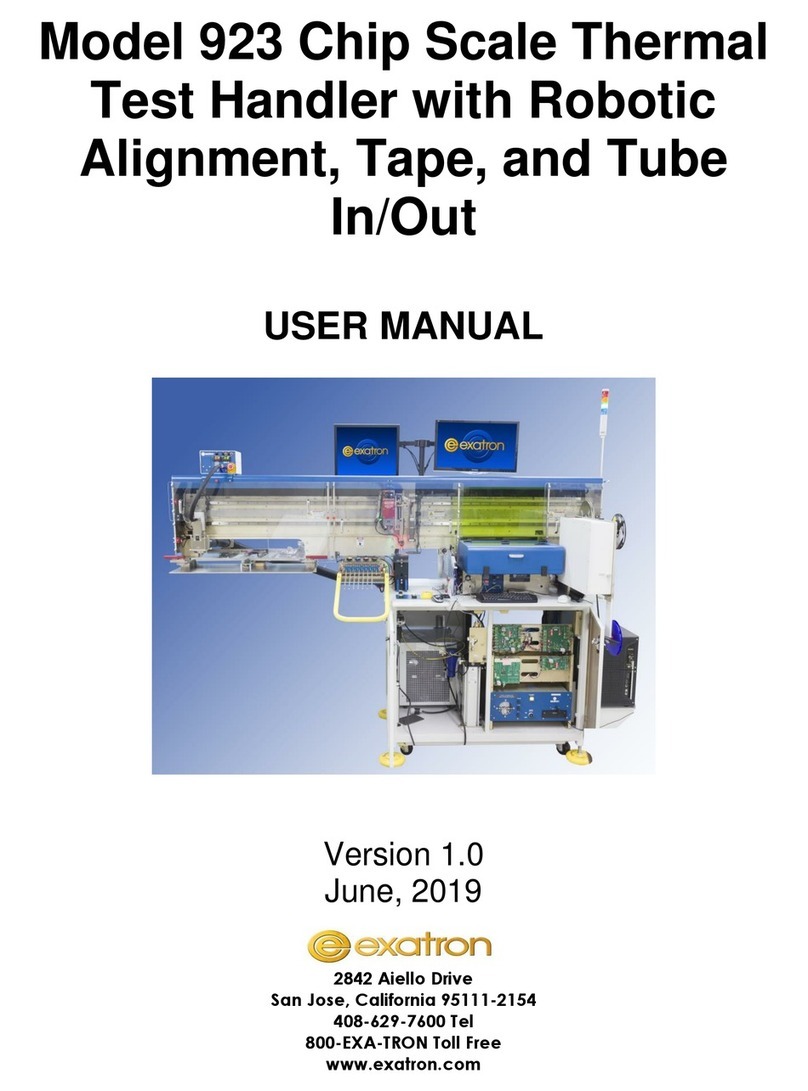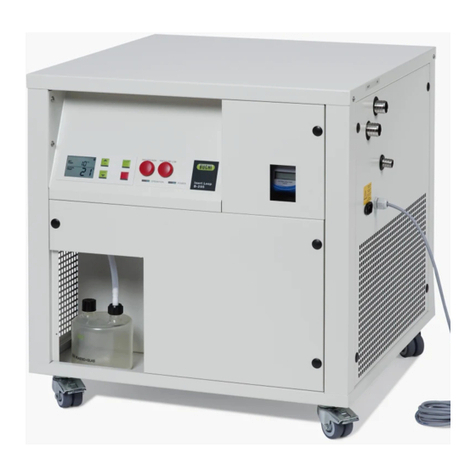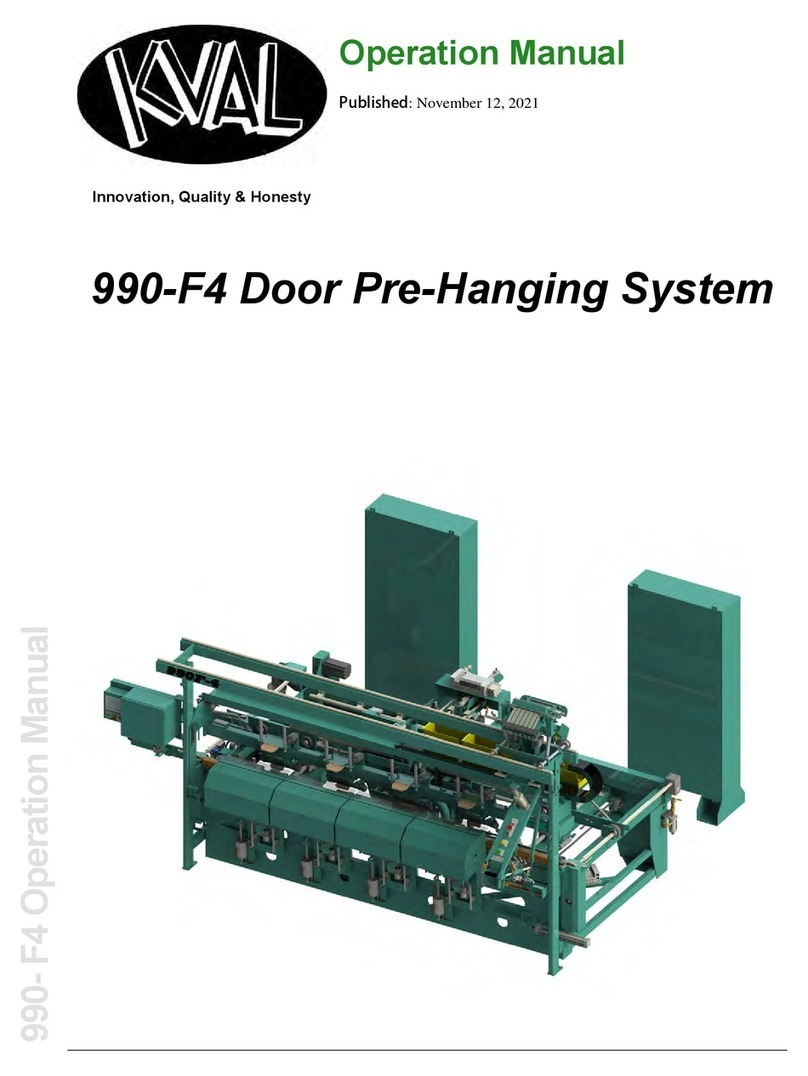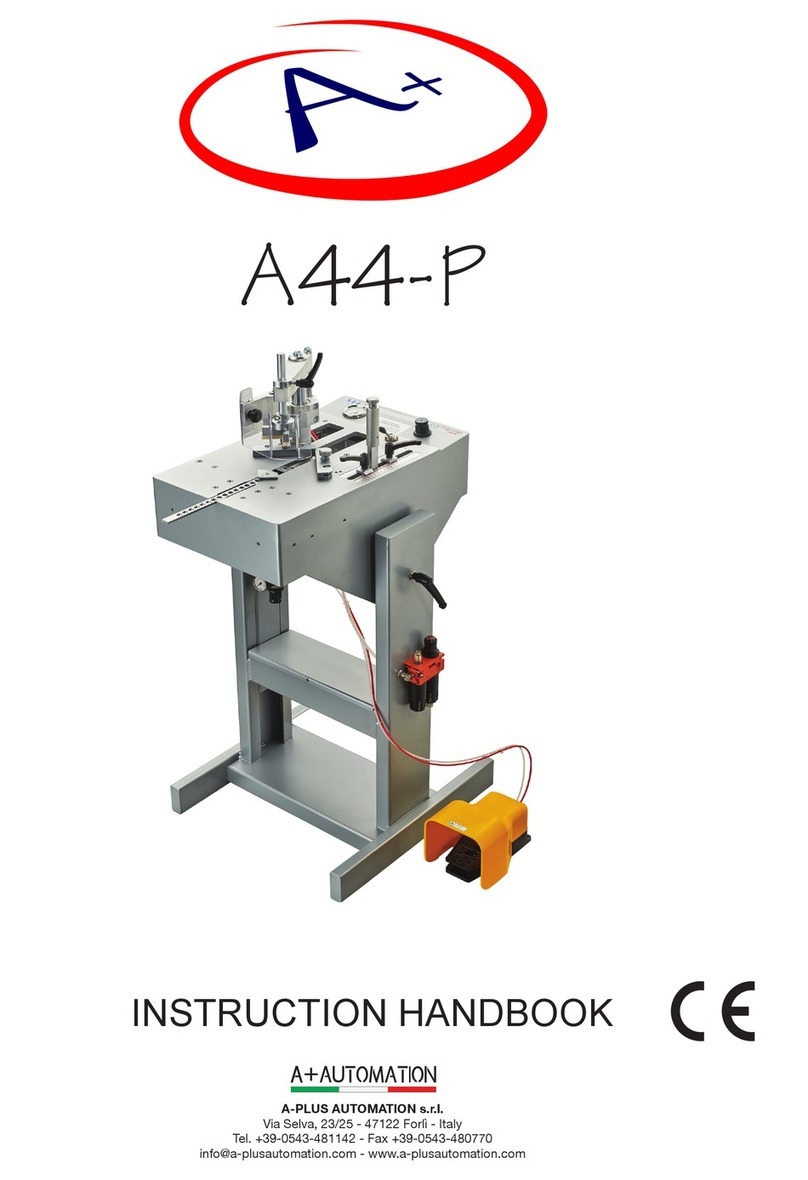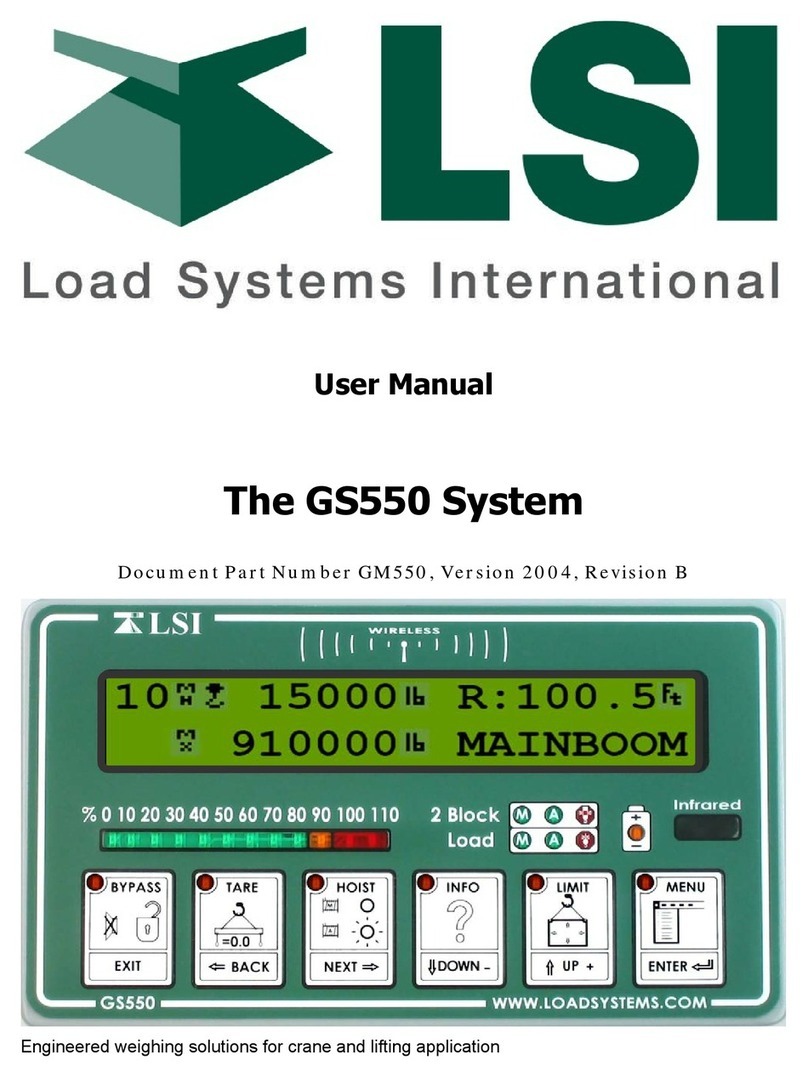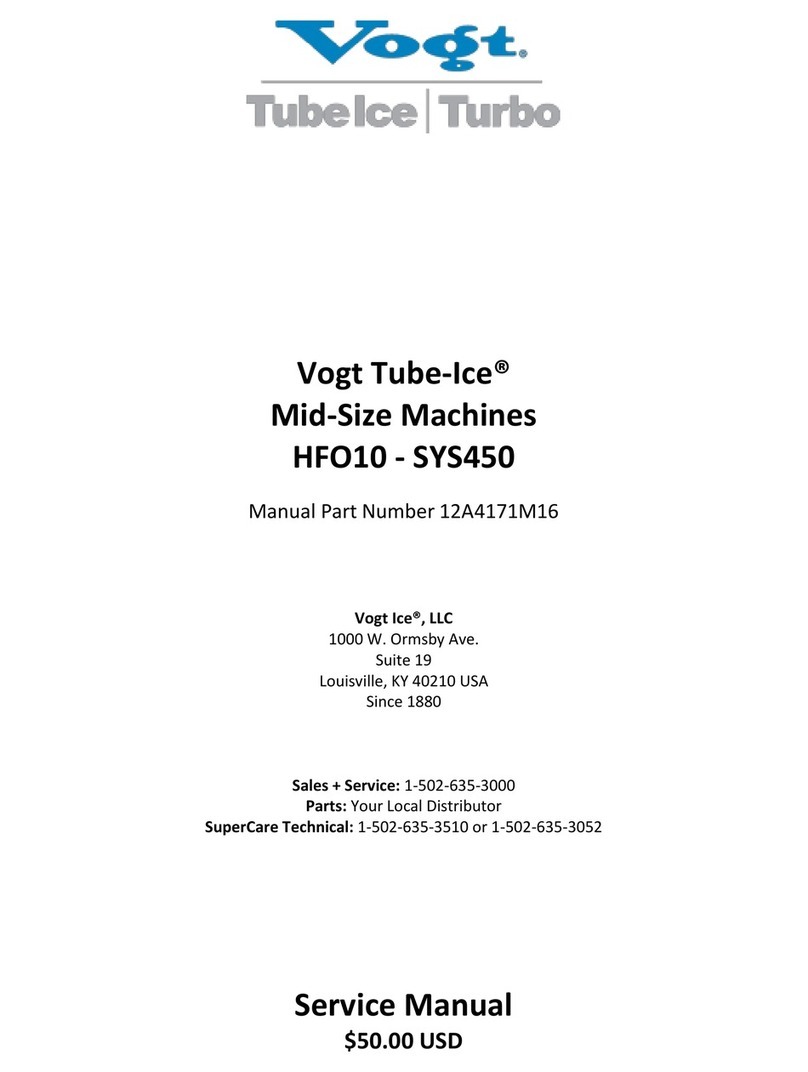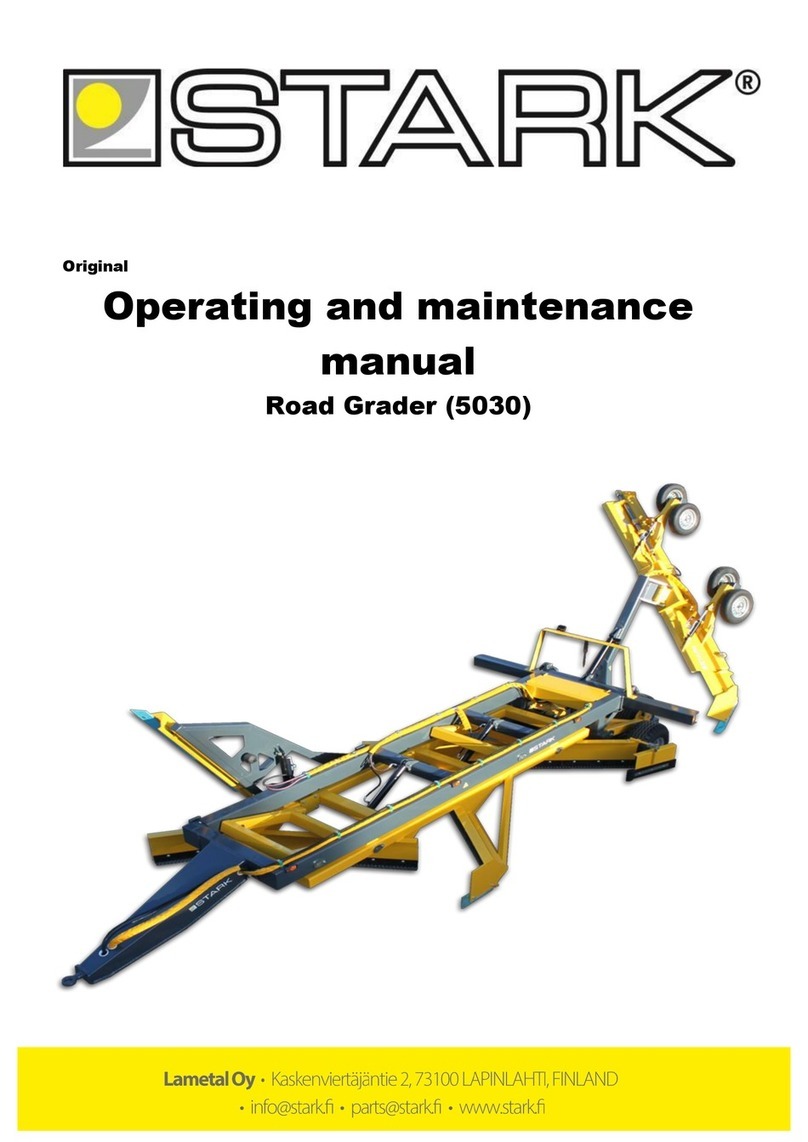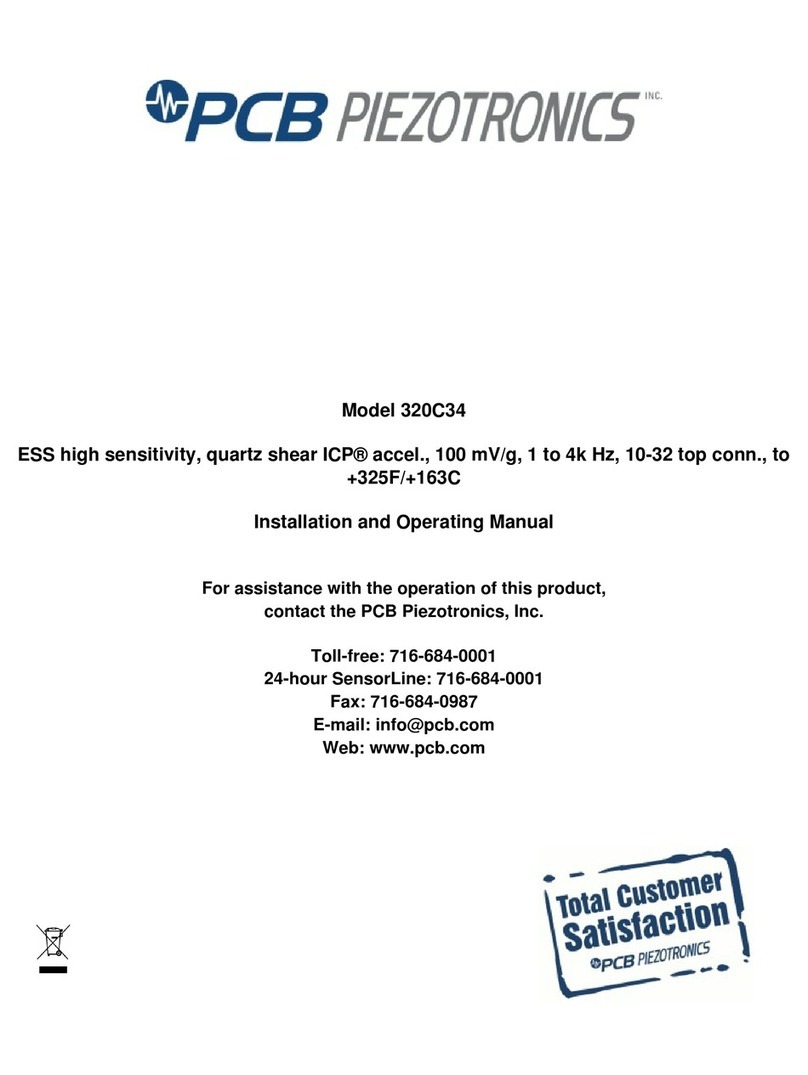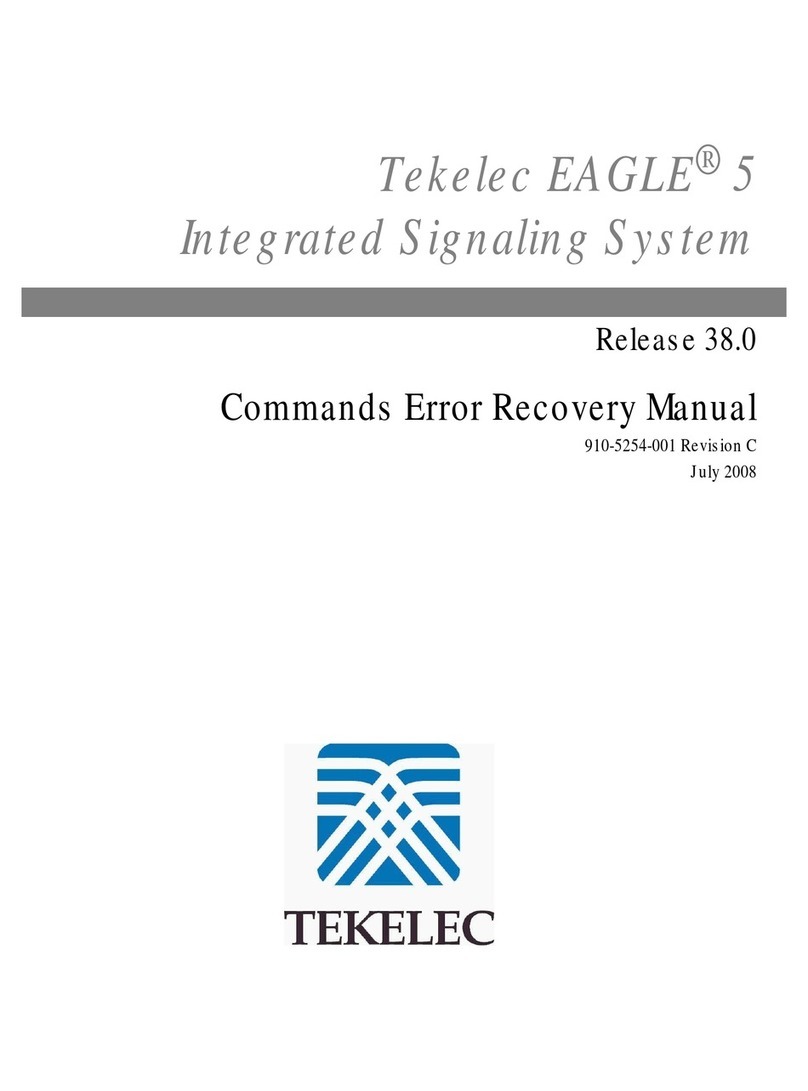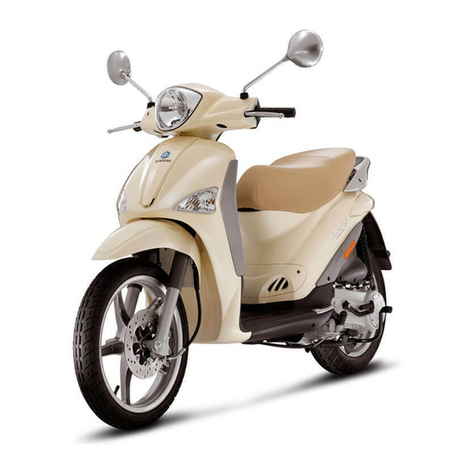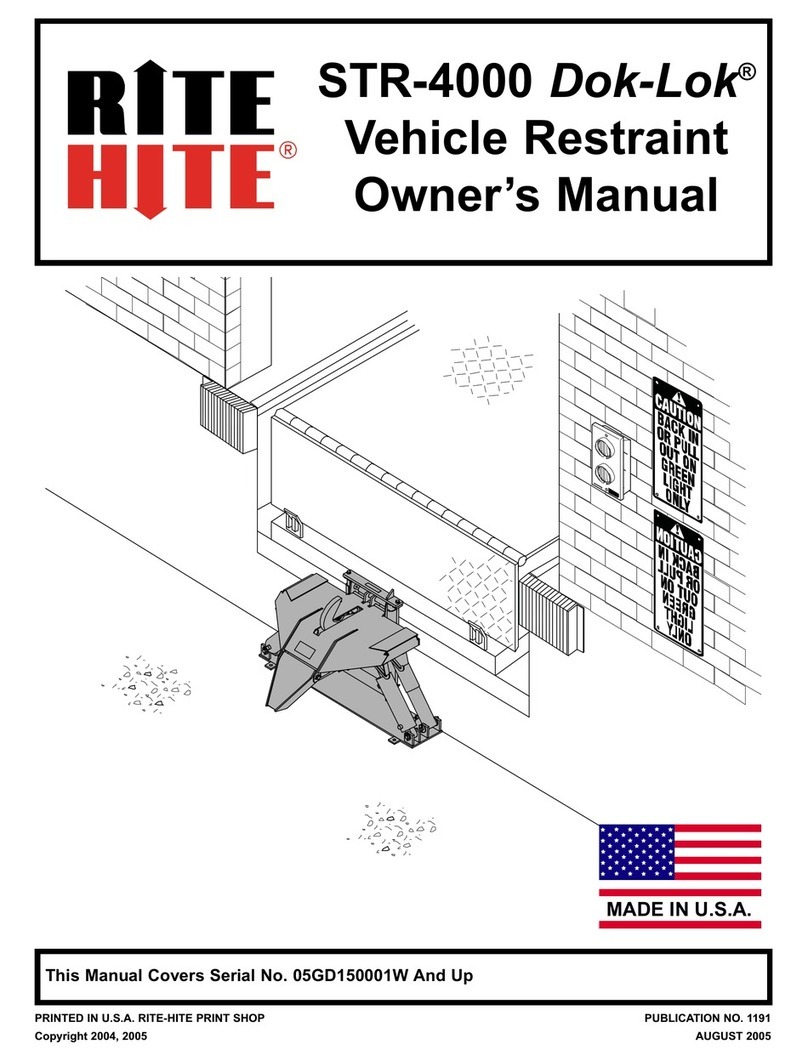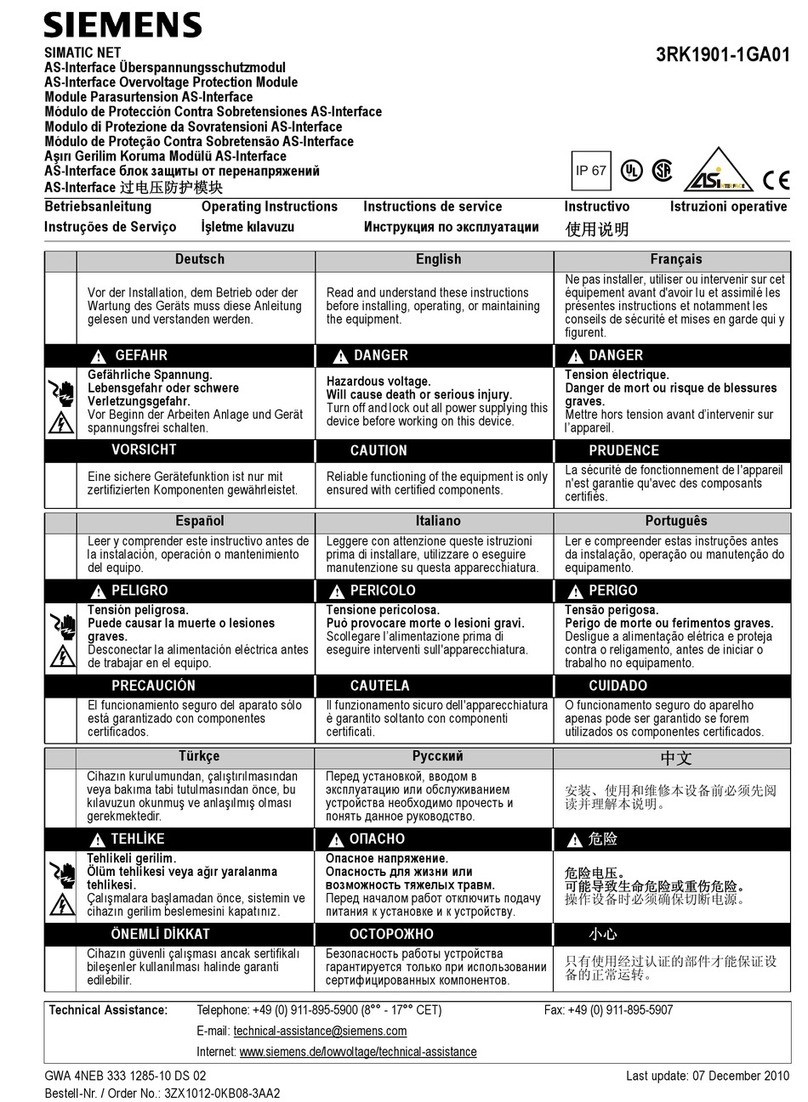General Measure Checkweigher User manual

Checkweigher
User’s Manual

©2013,Shenzhen General Measure Technology Co., Ltd reserve all copyright.
Without permission from Shenzhen General Measure Technology Co., Ltd,Any
corporations or person must not copy, spread, record or translate into other language
by any forms.
Our company reserved the right to update user’s manual without additional
notice to make perfect for customers. Thus please visit our website or contact with our
service person to get update information.
Website:http://www.szgmt.com

Contents
1 About this manual...............................................................................................1
Safe-keeping ............................................................................................1
Target group .............................................................................................1
Symbols used ...........................................................................................1
Warning notices........................................................................................1
2 Introduction.........................................................................................................3
Structure...................................................................................................3
Specifications...........................................................................................3
Intended use .............................................................................................4
Operating conditions................................................................................4
Warranty...................................................................................................5
3 Safety instructions...............................................................................................6
Trained Operator ......................................................................................6
Protective and safety devices...................................................................6
Main switch...................................................................................6
Sources of risk related to the system........................................................6
Components that start automatically.............................................6
Rotating parts................................................................................7
4 Installation...........................................................................................................8
5 Human machine interface ...................................................................................9
Main interface ..........................................................................................9
Sub interface ..........................................................................................11
6 Instruction of operation.....................................................................................12
Daily operation.......................................................................................12
Switch on device.........................................................................12
Switch off device ........................................................................13
Start and stop weight checking ...................................................13
Enter/modify data........................................................................13
Logon and logoff.........................................................................14
Product select..............................................................................15
Alarm clear..................................................................................16
Data inquiry ................................................................................16
Setup ......................................................................................................18
Product management...................................................................18
Basic maintenance ......................................................................22
Advanced maintenance ...............................................................25
7 Communication protocol and parameter...........................................................30
8 Maintenance......................................................................................................32
Cleaning .................................................................................................32
Maintenance...........................................................................................32
9 Troubleshooting ................................................................................................33
Alarm......................................................................................................33
Others.....................................................................................................33

Checkweigher user’s manual
1
1About this manual
Read the user manual before connecting and switching on the device. You will
find information on how to get maximum performance from the device as well as how
to avoid possible hazards.
This manual explains how to operate and set the device.
Safe-keeping
This manual is an integral part of the device and must be kept next to it, easily
accessible for all personnel.
If the device is resold, the complete user manual must be provided with it.
Target group
The device must be operated by trained personnel. This means that the operator
must be familiar with the content of this manual. Installation, servicing and repairs
must be performed by qualified personnel.
Symbols used
The following symbols are found in this manual:
Text with arrow prompts you to carry out an action.
○,1Position number in figure.
[Start belt] Text in bold within [] describes a physical button.
<OK>Text in bold within < > describes a key in operation interface.
”Display” Text in bold within “ ” indicates the display text.
Prerequisites have a gray background.
Warning notices
The signal word above the symbol indicates the risk level:
Source of danger with high risk with imminent danger for human!
The consequences are:
- critical injuries
- severe damage to health
Rules must be followed.

Checkweigher user’s manual
2
Source of danger, improper use!
Cause damage to property.

Checkweigher user’s manual
3
2Introduction
Structure
The checkweigher is available in different structure, an example is shown in the
figure.
○,1Alarm lamp
○,2Wind shield
○,3Weighing belt
○,4Input belt
○,5Electric control cabinet
○,6Foot screws
○,7Output belt
○,8Rejector
○,9[Start belt] (green) and [Stop belt] (red) button
○,10 Display and operating unit: 10"touch screen
Specifications
The specifications of checkweigher list in Table 2-1.
Table 2-1 Specifications of checkweigher
GM603B5
Max weighing range(g)
1200
Precision(g)
±
0.5
Max throughput(pieces/min)
150
Interval(g)
0.1

Checkweigher user’s manual
4
Weighing belt width(mm)
230
Weighing belt hight(mm)
750
±
30
Power
180-260V(AC),
50-60Hz
350VA
Protection
IP54
*The precision depend on the items checked and the field
condition, the precision here is the best precision the
checkweigher can achieve.
Intended use
- The device can be used for checking the weight of packaged foodstuffs or goods.
- It can be used in industrial or commercial fields.
- The goods to be checked must be fed to the scales via transport belt.
- The packages need to be fed continuously to the device with regular intervals
between the packages.
- The packages must be positioned on the centre of the belt when they are transported
over the scales.
Operating conditions
Do not install or commission equipment until the operating conditions have been
fulfilled:
- Temperature and air humidity:
Temperature: -10~40℃
Maximum humidity: 90% R.H without dew
- Vibration-free installation area
Vibrations can affect measurements made by the scales. During production,
avoid, for example, fork-lift truck activity near the device.
- Align horizontally
To ensure the precision of the scales, it is of absolute necessity that the device is
aligned horizontally.
- Draft
Drafts can affect the measurements made by the scales. If required, use the hood
over the weighing belt.
- Air convection
Free air convection must be able to form around the unit in order to avoid
inadmissible heating.
- Supply voltage
Power supply: 180-260VAC, 50Hz±10%
- Electrical charge
Packages may not be charged electrically when being transported to the transport
belts.
- Trained personnel:
Only trained personnel can maximize the performance of the device and avoid
risks.
- Written permission for changes:
Modifications to the devices require our prior written consent.

Checkweigher user’s manual
5
Please contact us or our competent customer service points if you have any
doubts concerning the practical application of these conditions.
Warranty
We do not accept any liability for damages resulting from:
- Non-compliance with our operating conditions and user’s manual.
- Unauthorized installation.
- Defective electrical installation by the customer.
- Structural changes to our equipment.
- Incorrect operation.
- Backup not executed.
- Natural wear and tear.
Guarantee is not given if defects/damage occur as a result of utilization by person we
have not authorized.
Check that our products are handled correctly and repeat training if necessary.

Checkweigher user’s manual
6
3Safety instructions
Trained Operator
The device must be operated by people who have been instructed in the
operating procedure.
The operator must read and understand the safety instructions in this manual.
Even though the device is equipped with all the required safety installations,
injuries to the operating personnel or damage to property is possible if the safety
instructions are not heeded.
Protective and safety devices
Main switch
The main switch is on the side of the switch cabinet. Switch the device off at the
main switch in the following situations:
- In the event of impending risk.
- When cleaning and maintenance work is being carried out on the outside of the
control cabinet.
Sources of risk related to the system
Components that start automatically
The device is designed for fully-automatic operations.
During fully-automatic operation, the transport belts and rejector, for example,
can be switched on and off automatically.
Keep fingers, hands or long hair away from the moving parts of the device.
Switch off the device by using main switch before carrying out cleaning and
maintenance work.
Electrical voltage in the control cabinet even when the
main switch is switched off!
Risk to life from an electrical charge.
Before carrying out work in the control cabinet, cut off
power and disconnect the power connector.
Work in the control cabinet must
be carried out by
qualified trained personnel.

Checkweigher user’s manual
7
3.3.1.1 Conveyor belts
Do not place any objects on the transport belts and do not use the transport belts
as a storage facility.
3.3.1.1 Rejector
Once the device is switched on, do not grab items in the rejector working area.
If necessary, install a protective hood over the rejector.
Pusher: Ensure that the height between pusher and belt is not more than 4 mm.
This setting makes sure that you cannot jam your fingers when the pusher pulls
away.
Rotating parts
The belt drive contains rotating parts. To avoid body part, hair or clothing being
caught and pulled into the machine, follow the instructions below:
Wear closely fitting clothes.
Do not wear necklaces, ties, or similar accessories.
Wear a hair net if you have long hair.

Checkweigher user’s manual
8
4Installation
The initial installation and commissioning as well as instruction in the operation,
cleaning, care and maintenance will be carried out by the responsible General
Measure Service Agent or the General Measure specialist adviser.

Checkweigher user’s manual
9
5Human machine interface
HMI with Touch Screen gives friendly access to information interaction between
user and checkweigher. The most frequently used interface of this device is the main
interface. Press key on main interface can enter sub interfaces. The sub interfaces
share same structure. Here give introduction of the main interface and structure of sub
interface.
Main interface
The main interface contains the following parts:
○,1Authorization level
Indicates which level the current user belongs to. The device has four different
authorization levels, which are
No log, in this situation, the user can only start checkweigher with the product
parameter which have been selected before;
Operator, having the access to change product to be checked;
Technician, having the access to product management and basic maintenance;
Engineer, manufacture level, having full access to all parameters.
○,2Stable sign
When current weight is stable, this sign comes up.
○,3Zero sign
When current weight is zero, this sign comes up.
○,4Current weight
The weight output by the device.
○,5Time information
Gives information of date and time.
○,6Operation key

Checkweigher user’s manual
10
○,7Basic statistical information of check result
“Over”Number of products checked as over.
“Pass” Number of products checked as pass.
“Under” Number of products checked as under.
○,8Basic information of current product
These information include:
“PD ID”Product identity.
“PD Name”Name of current product.
“Nominal weight” Nominal weight of the product.
“Upper deviation” Allowed value of actual weight over nominal weight.
“Lower deviation” Allowed value of actual weight under nominal weight.
“Throughput” Throughput of product.
“Checked”Numbers of product checked.
Entrance of product management and
system maintenance.
Set current weight to zero.
Start the weight checking process.
Stop the weight checking process.
<Setup>
<Zero>
<Zero>
<Stop>
<Start>
<User>
<Data>
<Product>
<Clear>
Link to change current user.
Link to weighing information.
Link to select product to be checked.
Used to clear alarm.
All alarms related information is list in
Table 9-1.

Checkweigher user’s manual
11
Sub interface
The sub-interfaces have same structure but with different function. The different
function will be introduced later.
○,1Name of sub-interface
○,2Information and functional key area of sub-interface
In addition to the keys present in main interface, there are some other keys in sub
interface:
<Next>
<Previous>
Go to next page.
Back to previous page
<Next>

Checkweigher user’s manual
12
6Instruction of operation
After correct installation, the device can be operated by touch screen, operation
procedure as follows:
In above operation procedure flow chart, “Product parameter” should be added
before any new product needed to be checked. “Calibration” should be carried out
when the device is installed the first time.
Daily operation
Switch on device
Prerequisites:
- The device has been installed properly and all wires have been connected correctly.
- The operating conditions listed in 2.4 have been fulfilled.
- The operator has been trained and operation procedure must comply with the safety
instructions listed in chapter 3.
- The weighing belt is empty.
Switch on the device at least 20 minutes before start weight
checking.
The pre-run aims to ensure the system reach the correct operating
temperature. Ignore the pre-run may cause negative effect on the
precision of the weighing result.
Fig 6-1 Operation procedure of Checkweigher
Power
Logon
Calibration
PD parameter
Stop
Product
Data
Start
Technician
Operator

Checkweigher user’s manual
13
Turn the main switch in a clockwise direction.
The main interface appears after a few seconds.
The default user level is no log.
Wait 20 minutes before weight checking.
Aims to ensure system reach the correct operating temperature.
Press <Start >.
Switch off device
Press <Stop >.
Turn the main switch in an anti-clockwise direction.
Start and stop weight checking
Prerequisites:
- Product to be checked has been selected.
- Product parameter has been set correctly.
- Calibration has been carried out.
- The device has been switched on for at least 20 minutes.
Start weight checking: Press <Start>.
Start weight checking process.
Stop weight checking: Press <Stop>.
Stop weight checking process.
Enter/modify data
A numerical keyboard which can be operated as a normal PC keyboard will pop
up when data input box is triggered.
Prerequisite:
- A data input box exists and it can be triggered to input data
-Click the input box.
A numerical keyboard with data description (on the left top) appears, as Fig
6-2.
Frequent breaks where the device is switched off can affect the
precision of the weighing result. Leave the device switched on during
short breaks in production. Do not switch off the device until
production is over.

Checkweigher user’s manual
14
Fig 6-2 Input box
Input data according to the data description.
The data description “Float: Product identity [1-50]” means the parameter is
“Product identity” and its input range is 1 to 50.
Press <OK> to confirm entered data or press <Cancel> to cancel and exit
Logon and logoff
Checkweigher has four user levels, the default level is no log, which can only
start the device to check one kind of product whose parameter has been set correctly
and selected. If you need to check more than one kind of product, you need to logon
with operator account. If product management or system maintenance need to be
carried out, logon with technician account will be requested. Steps of logon are as
follow:
Press <User> in main interface.
Enter user interface, as Fig 6-3.
Fig 6-3 User interface
Press <Logon> .
Pop up log on dialog box.

Checkweigher user’s manual
15
Fig 6-4 Log on dialog box
Select account. See Fig 6-4.
Input the password.
Initial password of operator and technician are 000000.
Press <OK>.
It comes to main interface with technician level authorization.
For the first time, please change the password yourself and keep it appropriately.
Press <Password> in user interface.
Change password interface pop up. See Fig 6-5.
Fig 6-5 Change password interface
After finished the operation which need to logon with specific user level, user
should logoff in case that others change the configuration and bring economic loss.
Press <Logoff> in user interface.
Product select
For the operator level user, it has no right to change product parameter, this
avoids incorrect parameter modification. The operator level user can only choose the
product parameter pre-defined by technician level user.

Checkweigher user’s manual
16
Logon with operator account.
Press <Product > in main interface.
Enter product select interface, as Fig 6-6.
Fig 6-6 Product select interface
Select the product to be checked according to its name.
Press <OK>.
Go back to main interface.
Alarm clear
The system will display alarm message if operation error occurs, the common
alarm list in Table 9-1. To continue operation, you need to clear the alarm message.
Press <Clear> in main interface (The <Clear> button will pop up in weight
display window when there is alarm message).
Data inquiry
The device has data storage and inquiry function.
Press <Data> in main interface.
Enter data inquiry interface, as Fig 6-7.
Fig 6-7 Data inquiry interface
Press <Statistic data>
Statistic information of batch can be inquired in ‘statistic data interface’, as

Checkweigher user’s manual
17
Fig 6-8.
Fig 6-8 Statistic data interface
This information of each product is recorded separately and it will be reset if
related product parameter is modified. If starting a new batch checking procedure
without changing product parameter, user needs to clear previous statistic information
of batch manually in ‘statistic data interface’; otherwise the new batch statistic
information will be added to previous information.
Press <Print>
When the RS232/RS485 selectable port is set to Print1 or Print2 and the printer
connect correctly, the statistic data will be printed.
Press <Delete>
The batch information will be reset.
Besides the statistic information, the device records every check result. The
weighing result can be viewed conveniently in weighing data interface.
Press <Weighing data> in data inquiry interface.
Enter weighing data interface, as Fig 6-9. All the checking results are
recorded here. <Home>, <PageUp>, <PageDown> and <End> are used for viewing
data.
Fig 6-9 Weighing data interface
Other manuals for Checkweigher
1
This manual suits for next models
1
Table of contents
Other General Measure Industrial Equipment manuals
